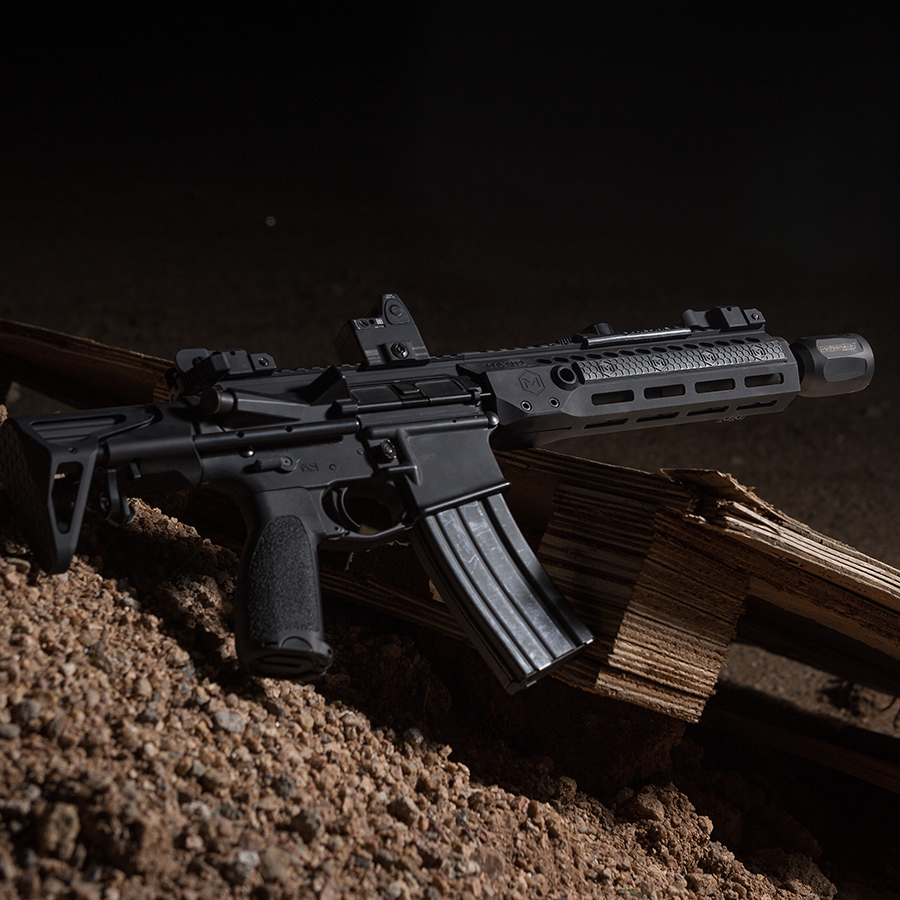Disclaimer: I am not a lawyer; no one in this office is a lawyer. This information is based on personal experience and research. Before you do anything involving a SBS, make sure you contact the local ATF Division about SBS laws in your state.
First, let me make this statement because I’m almost certain most of you see this as a pointless article (if that’s you, then this article probably isn’t for you). Simply put, the major difference is one shoots bullets, the other shotgun shells, and we know you know that. However, we’ve chosen to cover this because you wouldn’t believe how many people ask this question. So, here goes nothing…an extremely simple concept drug out to well over 1,500 words (you’re welcome).
To those of you asking the question, no hard feelings, we’re here to help. We’re aware that there’s a lot of new people coming into the gun world, especailly with everything going on. You are who this article is intended for. Although, we appreciate any and all readers.
So far, we’ve covered a lot on short barrel (or short-barreled) rifles. This blog is intended to take what you already know about the SBR and compare it to a short-barreled shotgun (SBS). Other than the obvious, what’s the difference between the two, federally speaking, and how do you legally acquire one?
If you haven’t been following our series on SBRs, now’s a good time to check them out, and then we’ll meet you back here for a little comparison talk.
The Difference Between an AR-15 Style Pistol and a Short Barrel Rifle
Size Matters | Short Barrel Rifle (SBR) Laws
Or you can just read on in our very short recap…
What’s a Short-Barreled Rifle
What’s a SBR? SBR stands for Short Barrel or Short-Barreled Rifle. Of course, when you’re talking legalities, there is an actual definition, which is critical knowledge, if you don’t want to commit a federal crime. Below are some important NFA definitions.

SBR: “Rifle having a barrel or barrels of less than 16 inches in length.”
Weapon Made From a Rifle: “Overall length of less than 26 inches or a barrel or barrels of less than 16 inches in length.”
- It’s not just SBRs regulated by the NFA. Anything that falls under the NFA defined firearm list must be registered, such as the SBS, which we’ll get to shortly. To do this, you’ll need to apply for your tax stamp. Once you have one of these fancy stamps, you can legally own or build your own SBR (or SBS).
- While it is legal, by federal standards, to own a SBR, some states say otherwise. Some states say it’s illegal to own a SBR for recreational use. However, they may allow ownership of curio or relic (C&R) firearms. Check with your local ATF division for further guidance.
C&R Ownership
To be considered for C&R, the firearm must fall into one of the below categories:
- Firearms which were manufactured at least 50 years prior to the current date, but not including replicas of such firearms;
- Firearms which are certified by the curator of a municipal, state, or federal museum which exhibits firearms to be curios or relics of museum interest; and
- Any other firearms which derive a substantial part of their monetary value from the fact that they are novel, rare, bizarre, or because of their association with some historical figure, period, or event.
Difference Between an AR-15 Style Pistol and a SBR
Typically, people who want to get around having to purchase a $200 tax stamp, buy an AR-15 style pistol, instead.

As a reminder, the difference between an AR-15 style pistol and SBR is the stock. One is intended to be shoulder-fired (SBR) and the other is not (AR-15 style pistol).
AR-15 Style Pistols: Uses a pistol brace (Does not require a tax stamp)
SBRs: Use a rifle stock (Requires a tax stamp)
Again, this is just a recap. If you want further information on things like ATF Open Letters, Court Cases, and fine-print legalities, you should read our blog on SBR Laws.
What’s a Short-Barreled Shotgun

Now that our short review session is over, what’s a Short-Barreled Shotgun (SBS)? Well, let’s start off with a couple definitions.
Accord to the ATF, “The NFA defines shotgun, in part, as a weapon designed or redesigned, made or remade, and intended to be fired from the shoulder and designed or redesigned and made or remade to use the energy of the explosive in a fixed shotgun shell to fire through a smooth bore either a number of projectiles (ball shot) or a single projectile for each pull of the trigger.
“A shotgun is a firearm subject to the NFA if the shotgun has a barrel or barrels of less than 18 inches in length. A weapon made from a shotgun is also a firearm subject to the NFA if the weapon as modified has an overall length of less than 26 inches or a barrel or barrels of less than 18 inches in length.”
[26 U.S.C. §§ 5845(a)(1)-(2), (d)]
So, the difference between a SBR and SBS, other than the fact that one’s a rifle and the other a shotgun?
SBR: “Rifle having a barrel or barrels of less than 16 inches in length.”
SBS: “Shotguns having a barrel or barrels of less than 18 inches in length.”
Weapon Made From a Rifle: “Overall length of less than 26 inches or a barrel or barrels of less than 16 inches in length.”
Weapon Made from a Shotgun: “Overall length of less than 26 inches or a barrel or barrels of less than 18 inches in length. Both stock and barrel altered.”
Both have an overall length less than 26-in, and both are intended to be fired from the shoulder.
Are Short-Barreled Shotguns Legal
If you want to own a SBS, much like a SBR, you’ll need a tax stamp. Why? Because a SBS is an NFA classified firearm.
So, yes, it’s completely legal to own and build a SBS if your state allows it and you have a tax stamp (as of the publication date of this article).
If you aren’t sure how to get a tax stamp, check out our blog: Are Short Barrel Rifles Legal | How to get a Tax Stamp
The NFA and Intent
Basically, shotguns are intended to be fired from the shoulder, hence the shoulder stock. A shotgun with an altered shoulder stock, a barrel less than 18”, and an overall length less than 26” is considered an NFA firearm.
As stated above, a shotgun is intended to be shoulder-fired. It’s also intended to use shotgun shells fired through a smooth bore, with one projectile shot per trigger pull.
If the barrel is under 18”, then you have a SBS, according to the NFA definition.
However, let’s say you have s shotgun with a 14” barrel? The configuration/intended firing position will change its classification from NFA-regulated SBS to non-NFA regulated firearm. For example, it might have a barrel length less than 18”, but if it has an overall length over 26” and uses a pistol grip, like the Mossberg 590 Shockwave, then it isn’t intended to be shoulder-fired, and it doesn’t fall under the NFA regulated firearm list. It’s kind of like the difference between an AR-15 style pistol and a SBR, it’s all in how it’s “intended” to be fired.
NFA Definitions
To help make things easier (or maybe not) below is a list of the definitions taken directly from the ATF’s website.
Short-Barreled Shotgun (SBS): “Shotguns having a barrel or barrels of less than 18 inches in length.”
Of course, it’s not just SBS’ that are regulated by the NFA, weapons made from shotguns are regulated as well.
Weapon Made from a Shotgun: “Overall length of less than 26 inches or a barrel or barrels of less than 18 inches in length. Both stock and barrel altered.”
And then you have this guy…
12-gauge Crude Manufacture: “Barrel less than 18 inches and/or overall length less than 26 inches, stock altered, barrel cut down. Often mistakenly called a ‘sawed-off shotgun.’ In this instance, overall length is the determining factor. However, if the overall length is 26 inches or more and barrel less than 18 inches, this weapon would still be classified as a firearm under the [NFA].”
And this one too…
Any Other Weapon (AOW): “Any weapon or device capable of being concealed on the person from which a shot can be discharged through the energy of an explosive, a pistol or revolver having a barrel with a smoothbore designed or redesigned to fire a fixed shotgun shell, weapons with combination shotgun and rifle barrels 12 inches or more, less than 18 inches in length, from which only a single discharge can be made from either barrel without manual reloading, and shall include any such weapon which may be readily restored to fire. Such term shall not include a pistol or a revolver having a rifled bore, or rifled bores, or weapons designed, made, or intended to be fired from the shoulder and not capable of firing fixed ammunition.”
Weapons Regulated by the NFA
For further informational purposes, reviewed May 2020, here are the weapons regulated under the NFA.
- A shotgun having a barrel or barrels of less than 18 inches in length;
- A weapon made from a shotgun if such weapon as modified has an overall length of less than 26 inches or a barrel or barrels of less than 18 inches in length;
- A rifle having a barrel or barrels of less than 16 inches in length;
- A weapon made from a rifle if such weapon as modified has an overall length of less than 26 inches or a barrel or barrels of less than 16 inches in length;
- Any other weapon, as defined in subsection (e);
- A machinegun;
- Any silencer (as defined in section 921 of title 18, United States Code); and
- A destructive device.
[26 U.S.C. 5845; 27 CFR 479.11]
Disclaimer: Again, I am not a lawyer; no one in this office is a lawyer. This information is based on personal experience and research. Before you do anything involving a SBS, make sure you contact the local ATF Division about SBS laws in your state.
Did we miss anything? Do you have further recommendations? Please, comment below. We love hearing from our readers!
Looking for more content? Check out some of our other stuff!
SBR vs. AR-15 | Daniel Defense
700 Chassis Pistol (CP) Versus Maxim Defense MD-15 | 2020 Review








Leave a Reply
Your email address will not be published. Required fields are marked *